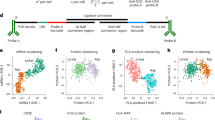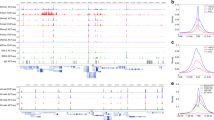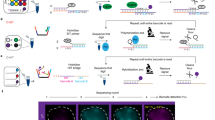Abstract
Analysis at the single-cell level is essential for the understanding of cellular responses in heterogeneous cell populations, but it has been difficult to perform because of the strict requirements put on detection methods with regard to selectivity and sensitivity (i.e., owing to the cross-reactivity of probes and limited signal amplification). Here we describe a 1.5-d protocol for enumerating and genotyping mRNA molecules in situ while simultaneously obtaining information on protein interactions or post-translational modifications; this is achieved by combining padlock probes with in situ proximity ligation assays (in situ PLA). In addition, we provide an example of how to design padlock probes and how to optimize staining conditions for fixed cells and tissue sections. Both padlock probes and in situ PLA provide the ability to directly visualize single molecules by standard microscopy in fixed cells or tissue sections, and these methods may thus be valuable for both research and diagnostic purposes.
This is a preview of subscription content, access via your institution
Access options
Subscribe to this journal
Receive 12 print issues and online access
$259.00 per year
only $21.58 per issue
Buy this article
- Purchase on Springer Link
- Instant access to full article PDF
Prices may be subject to local taxes which are calculated during checkout





Similar content being viewed by others
References
Levsky, J.M. & Singer, R.H. Gene expression and the myth of the average cell. Trends Cell Biol. 13, 4–6 (2003).
Raj, A., Peskin, C.S., Tranchina, D., Vargas, D.Y. & Tyagi, S. Stochastic mRNA synthesis in mammalian cells. PLoS Biol. 4, e309 (2006).
Kaufmann, B.B. & van Oudenaarden, A. Stochastic gene expression: from single molecules to the proteome. Curr. Opin. Genet. Dev. 17, 107–112 (2007).
Huang, S. Non-genetic heterogeneity of cells in development: more than just noise. Development 136, 3853–3862 (2009).
Larsson, C., Grundberg, I., Soderberg, O. & Nilsson, M. In situ detection and genotyping of individual mRNA molecules. Nat. Methods 7, 395–397 (2010).
Soderberg, O. et al. Direct observation of individual endogenous protein complexes in situ by proximity ligation. Nat. Methods 3, 995–1000 (2006).
Jarvius, M. et al. In situ detection of phosphorylated platelet-derived growth factor receptor beta using a generalized proximity ligation method. Mol. Cell Proteomics 6, 1500–1509 (2007).
Weibrecht, I., Grundberg, I., Nilsson, M. & Soderberg, O. Simultaneous visualization of both signaling cascade activity and end-point gene expression in single cells. PLoS ONE 6, e20148 (2011).
Larsson, C. et al. In situ genotyping individual DNA molecules by target-primed rolling-circle amplification of padlock probes. Nat. Methods 1, 227–232 (2004).
Liu, Y. et al. Western blotting via proximity ligation for high-performance protein analysis. Mol. Cell Proteomics 10, O111.011031 (2011).
Clausson, C.M. et al. Increasing the dynamic range of in situ PLA. Nat. Methods 8, 892–893 (2011).
Weibrecht, I. et al. Visualising individual sequence-specific protein-DNA interactions in situ. N. Biotechnol. 29, 589–598 (2012).
Shaposhnikov, S., Larsson, C., Henriksson, S., Collins, A. & Nilsson, M. Detection of Alu sequences and mtDNA in comets using padlock probes. Mutagenesis 21, 243–247 (2006).
Wamsley, H.L. & Barbet, A.F. In situ detection of Anaplasma spp. by DNA target-primed rolling-circle amplification of a padlock probe and intracellular colocalization with immunofluorescently labeled host cell von Willebrand factor. J. Clin. Microbiol. 46, 2314–2319 (2008).
Andersson, C., Henriksson, S., Magnusson, K.E., Nilsson, M. & Mirazimi, A. In situ rolling circle amplification detection of Crimean Congo hemorrhagic fever virus (CCHFV) complementary and viral RNA. Virology 426, 87–92 (2012).
Leuchowius, K.J., Weibrecht, I., Landegren, U., Gedda, L. & Soderberg, O. Flow cytometric in situ proximity ligation analyses of protein interactions and post-translational modification of the epidermal growth factor receptor family. Cytometry A 75, 833–839 (2009).
Zieba, A. et al. Bright-field microscopy visualization of proteins and protein complexes by in situ proximity ligation with peroxidase detection. Clin. Chem. 56, 99–110 (2010).
John, H.A., Birnstiel, M.L. & Jones, K.W. RNA-DNA hybrids at the cytological level. Nature 223, 582–587 (1969).
Gall, J.G. & Pardue, M.L. Formation and detection of RNA-DNA hybrid molecules in cytological preparations. Proc. Natl. Acad. Sci. USA 63, 378–383 (1969).
Femino, A.M., Fay, F.S., Fogarty, K. & Singer, R.H. Visualization of single RNA transcripts in situ. Science 280, 585–590 (1998).
Raj, A., van den Bogaard, P., Rifkin, S.A., van Oudenaarden, A. & Tyagi, S. Imaging individual mRNA molecules using multiple singly labeled probes. Nat. Methods 5, 877–879 (2008).
Emmert-Buck, M.R. et al. Laser capture microdissection. Science 274, 998–1001 (1996).
Espina, V. et al. Laser-capture microdissection. Nat. Protoc. 1, 586–603 (2006).
Kenworthy, A.K. Imaging protein-protein interactions using fluorescence resonance energy transfer microscopy. Methods 24, 289–296 (2001).
Cremazy, F.G. et al. Imaging in situ protein-DNA interactions in the cell nucleus using FRET-FLIM. Exp. Cell Res. 309, 390–396 (2005).
Hu, C.D., Chinenov, Y. & Kerppola, T.K. Visualization of interactions among bZIP and Rel family proteins in living cells using bimolecular fluorescence complementation. Mol. Cell. 9, 789–798 (2002).
Soderberg, O. et al. Characterizing proteins and their interactions in cells and tissues using the in situ proximity ligation assay. Methods 45, 227–232 (2008).
Leuchowius, K.J., Weibrecht, I. & Soderberg, O. In situ proximity ligation assay for microscopy and flow cytometry. Curr. Protoc. Cytom. 56, 9.36.1–9.36.15 (2011).
Acknowledgements
This work was supported by grants from the Swedish Research Council, the Wallenberg Foundation and the EU FP7 projects 278568 (PRIMES), 259796 (DIATOOLS) and 201418 (READNA). B.K. is supported by the Deutsche Forschungsgemeinschaft (Ko 4345/1-1).
Author information
Authors and Affiliations
Corresponding authors
Ethics declarations
Competing interests
M.N. holds stock in Olink Bioscience, which holds the commercial rights to the padlock and proximity ligation assays.
Rights and permissions
About this article
Cite this article
Weibrecht, I., Lundin, E., Kiflemariam, S. et al. In situ detection of individual mRNA molecules and protein complexes or post-translational modifications using padlock probes combined with the in situ proximity ligation assay. Nat Protoc 8, 355–372 (2013). https://doi.org/10.1038/nprot.2013.006
Published:
Issue Date:
DOI: https://doi.org/10.1038/nprot.2013.006
This article is cited by
-
Chemiluminescent screening of specific hybridoma cells via a proximity-rolling circle activated enzymatic switch
Communications Biology (2022)
-
Demystifying biotrophs: FISHing for mRNAs to decipher plant and algal pathogen–host interaction at the single cell level
Scientific Reports (2020)
-
Quantification and localization of oncogenic receptor tyrosine kinase variant transcripts using molecular inversion probes
Scientific Reports (2018)
-
Single-cell protein-mRNA correlation analysis enabled by multiplexed dual-analyte co-detection
Scientific Reports (2017)
-
Visualization of tumor heterogeneity by in situ padlock probe technology in colorectal cancer
Histochemistry and Cell Biology (2017)
Comments
By submitting a comment you agree to abide by our Terms and Community Guidelines. If you find something abusive or that does not comply with our terms or guidelines please flag it as inappropriate.



